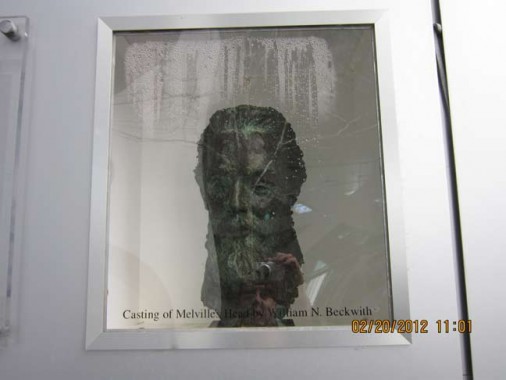William Beckwith‘s sculpture of the head of Moby-Dick author Herman Melville can be chanced upon at 17 Pearl Street, between State and Whitehall, which is across the way from #6 Pearl, where Melville was born in 1819. When his best known book about the Great White was not an immediate success in 1851, he became a customs inspector; his work became acclaimed only after his death 40 years later.
At #17 State you can still see the exterior of the New York Unearthed museum, which has been closed for nearly a decade. It was a center for urban archeology that opened in October 1990 and exhibited objects from the colonial era that were discovered by crews working on various construction projects downtown. Of the 2 million objects that comprise the largest trove of archeological objects from New York City’s past, there is a handful of coffee beans from an 1835 fire, ancient oyster shells, Delftware china brought here by the Dutch, some of it from China; porcelain marbles from the bygone Greenwich Village of Henry James; a coin from 1590 that is believed to be the oldest European object found within the five boroughs; and much, much more. The two-story space was designed by the studio of Milton Glaser, famed for his “I Love NY” logo.
After the museum closed in 2005 because its patron, the South Street Seaport, ended funding, most of the contents were moved to an Albany museum. The bust has now also departed, for parts unknown.
Herman Melville, from Moby-Dick:
Circumambulate the city of a dreamy Sabbath afternoon. Go from Corlears Hook to Coenties Slip, and from thence, by Whitehall northward. What do you see? – Posted like silent sentinels all around the town, stand thousands upon thousands of mortal men fixed in ocean reveries. Some leaning against the spiles; some seated upon the pier-heads; some looking over the bulwarks of ships from China; some high aloft in the rigging, as if striving to get a still better seaward peep. But these are all landsmen; of week days pent up in lath and plaster – tied to counters, nailed to benches, clinched to desks. How then is this? Are the green fields gone? What do they here?…
Say, you are in the country; in some high land of lakes. Take almost any path you please, and ten to one it carries you down in a dale, and leaves you there by a pool in the stream. There is magic in it. Let the most absent- minded of men be plunged in his deepest reveries – stand that man on his legs, set his feet a-going, and he will infallibly lead you to water, if water there be in all that region. Should you ever be athirst in the great American desert, try this experiment, if your caravan happen to be supplied with a metaphysical professor. Yes, as every one knows, meditation and water are wedded for ever.
Photo by Richard Melnick
